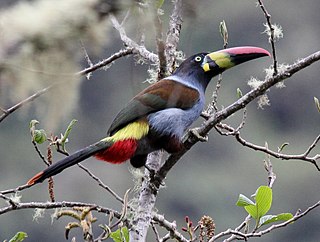
The toucan barbet is a barbet native to western Ecuador and Colombia. Along with the prong-billed barbet, it forms the family Semnornithidae, and is closely related to the toucans. It is a medium-sized barbet with a robust yellow bill. It has striking plumage, having a black head with grey throat and nape, red breast and upper belly, yellow lower belly and grey wings and tail.

The scarlet-rumped cacique is a passerine bird species in the New World family Icteridae. It breeds from eastern Honduras to Panama and in the Pacific lowlands of South America from western Colombia south to Ecuador, and in the lower reaches of the northern Andes. There are several subspecies, some of which have been proposed for elevation to full species status.

The yellow-throated toucan is a large toucan in the family Ramphastidae found in Central and northern South America.

The Choco toucan is a near-passerine bird in the family Ramphastidae found in humid lowland and foothill forests on the Pacific slope of Colombia and Ecuador. Within its range, extensive habitat destruction is taking place, but it remains fairly common locally.

The Tropical Andes is northern of the three climate-delineated parts of the Andes, the others being the Dry Andes and the Wet Andes. The Tropical Andes' area spans 1,542,644 km2 (595,618 sq mi).

The yellow-eared parrot is an endangered parrot of the tropics in South America. It is found in the Andes of Colombia. This species was thought to be extinct up until April 1999, when a group of researchers that were sponsored by ABC and Fundación Loro Parque, discovered a total of 81 individuals in the Colombian Andes. It is currently enlisted as vulnerable on the International Union for Conservation of Nature (IUCN) Red List. Its current population trend is increasing, in part due to conservation measures implemented to protect the existing populations of the species. It is closely associated with the wax palm.

The Cocora valley is a valley in the Quindío Department of Colombia. It is located in the Central Cordillera of the Andean mountains. "Cocora" was the name of a Quimbayan princess, daughter of the local chief Acaime, and means "star of water".

The buff-tailed sicklebill is a species of hermit hummingbird from the lower Andes and adjacent west Amazonian lowlands from southern Colombia and northern Ecuador to Peru and Bolivia.

The wattled guan is a species of bird in the family Cracidae. It is a fairly large black cracid with blue-based, black-tipped beak and a long, red-and-yellow wattle.

The ocellated tapaculo is a large bird found in the northern Andes in South America. It is a highly distinctive tapaculo; traditionally united with its closest relatives in the Rhinocryptidae, this family is paraphyletic with the Formicariidae (ground-antbirds) but instead of merging the tapaculos with the ground-antbird family, recent sources tend to split the antpittas from the Formicariidae.

The turquoise jay is a species of bird in the family Corvidae.

The yellow-bellied chat-tyrant is a species of passerine bird in the family Tyrannidae. It is 12–12.5 cm (4.7–4.9 in) in length. It is a chunky bird with a short, thin bill. It is mostly olive with an ochre yellow forehead and long yellow eyebrow. It has dusky colored wings and tail with two rufous tail bars. It is mostly found in Colombia, Ecuador, Peru, and Venezuela. It feeds in separated pairs hunting near the ground in foliage.

The fiery-throated fruiteater is a species of bird in the family Cotingidae. It is found in Colombia, Ecuador, and Peru where its natural habitats are subtropical or tropical moist lowland forests and subtropical or tropical moist montane forests. It is becoming rare due to habitat destruction of its rainforest habitat.

The red-ruffed fruitcrow is a species of bird in the monotypic genus Pyroderus. It belongs to the family Cotingidae, and is one of the largest passerines in South America. Its common names in Spanish include yacutoro,toropisco montañero,sangretoro,pájaro torero, and cuervo-frutero de garganta roja. This species was first named Coracias scutata by Shaw in 1792, but was later changed to the current scientific name. This species has five subspecies P. s. scutatus, P. s. orenocensis, P. s. granadensis, P. s. masoni, P. s. occidentalsis.

The great thrush is a species of bird in the family Turdidae. It is found in Bolivia, Colombia, Ecuador, Peru, and Venezuela. It is considered as the largest thrush in South America. The great thrush's size distinguishes it from the several other uniform slaty-colored thrushes in its range. It inhabits subtropical or tropical moist montane forests and high-altitude shrubland, but can also make use of degraded forest and urban areas.

The hooded mountain toucan is a species of bird in the family Ramphastidae. It is found in humid highland forests in the Andes from south-eastern Peru to central Bolivia. This species was originally described in the genus Pteroglossus.

Andigena, the mountain toucans, is a genus of birds in the family Ramphastidae. They are found in humid highland forests in the Andes of South America, ranging from Bolivia to Venezuela. These medium-sized toucans all have olive-brown upperparts, a black crown, yellow rump, blue-grey underparts and a red vent.

The grey-breasted mountain toucan is a species of bird in the family Ramphastidae found in humid highland forest, often at the tops of the trees, in the Andes of southern Colombia, Ecuador and Peru. It remains locally fairly common, but has declined due to habitat loss.

The black-billed mountain toucan is a species of bird in the family Ramphastidae. It is found in humid highland forests in the Andes of western Venezuela, Colombia, Ecuador and far northern Peru. It is the only mountain-toucan with a white throat. Despite its name, only the nominate subspecies has an entirely black bill, while both A. n. occidentalis and A. n. spilorhyncha have bills that are coloured chestnut and black.

The white-throated toucanet is a near-passerine bird found in the Andes from western Venezuela, through Colombia to northern Ecuador.























